HI6027 Business and Corporations Law: Kokotovich Constructions Report
VerifiedAdded on 2021/06/17
|9
|2826
|23
Report
AI Summary
This report provides a comprehensive analysis of the Kokotovich Constructions Pty Ltd v Wallington case, focusing on breaches of the Corporations Act and fiduciary duties. The report examines the facts of the case, including the personal and business relationships between the parties involved, and the issues surrounding the allotment of shares. It explores the legal arguments presented, the court's decisions at both the primary and appellate levels, and the reasoning behind those decisions. The analysis includes a discussion of the relevant sections of the Corporations Act, such as section 54 regarding share allotment, and the violation of fiduciary duties. Furthermore, the report assesses the impact of the decision on Australian corporations law, highlighting its relevance to the development of legal principles and the operation of companies. The report concludes with a critical evaluation of the court's findings and their implications.
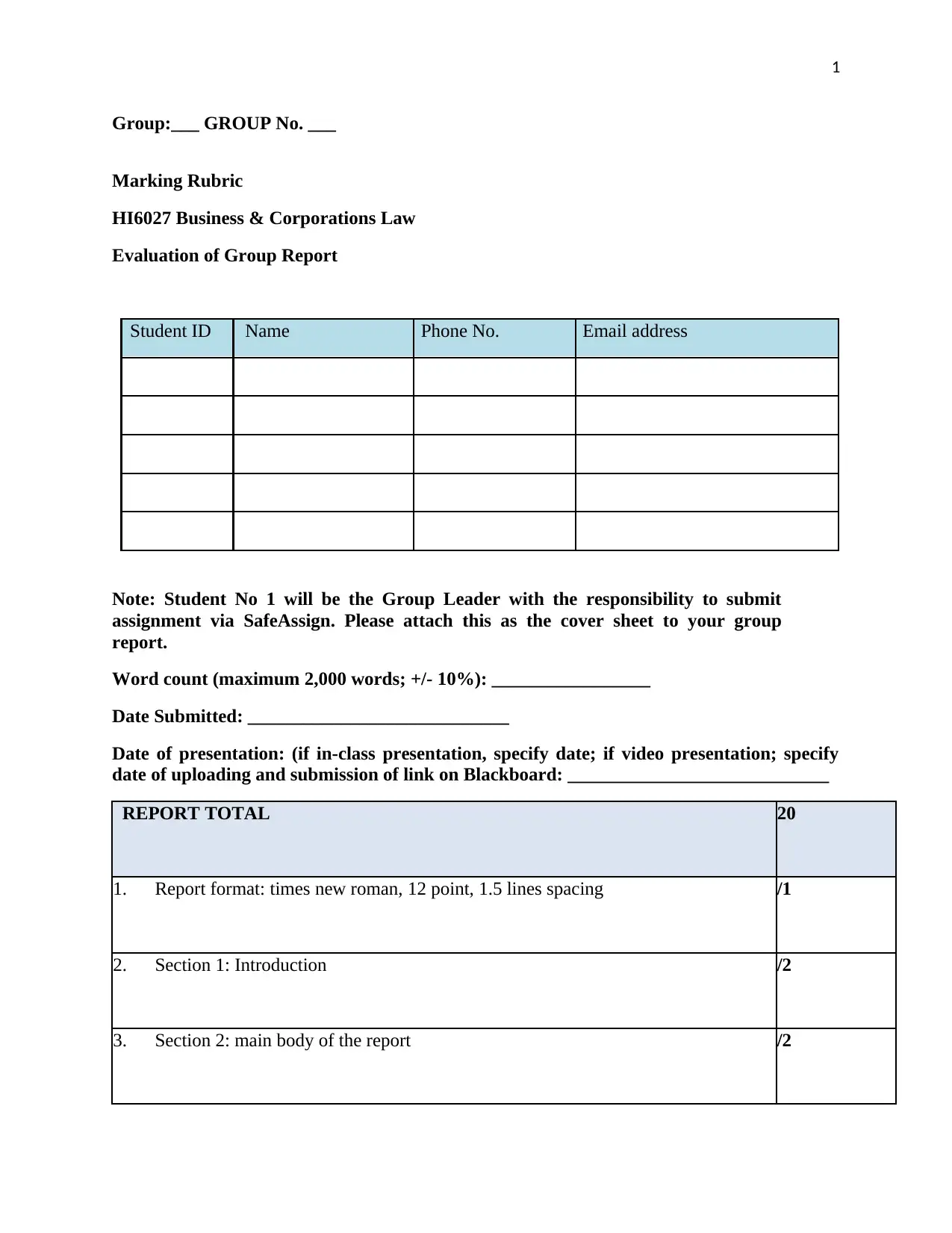
1
Group:___ GROUP No. ___
Marking Rubric
HI6027 Business & Corporations Law
Evaluation of Group Report
Student ID Name Phone No. Email address
Note: Student No 1 will be the Group Leader with the responsibility to submit
assignment via SafeAssign. Please attach this as the cover sheet to your group
report.
Word count (maximum 2,000 words; +/- 10%): _________________
Date Submitted: ____________________________
Date of presentation: (if in-class presentation, specify date; if video presentation; specify
date of uploading and submission of link on Blackboard: ____________________________
REPORT TOTAL 20
1. Report format: times new roman, 12 point, 1.5 lines spacing /1
2. Section 1: Introduction /2
3. Section 2: main body of the report /2
Group:___ GROUP No. ___
Marking Rubric
HI6027 Business & Corporations Law
Evaluation of Group Report
Student ID Name Phone No. Email address
Note: Student No 1 will be the Group Leader with the responsibility to submit
assignment via SafeAssign. Please attach this as the cover sheet to your group
report.
Word count (maximum 2,000 words; +/- 10%): _________________
Date Submitted: ____________________________
Date of presentation: (if in-class presentation, specify date; if video presentation; specify
date of uploading and submission of link on Blackboard: ____________________________
REPORT TOTAL 20
1. Report format: times new roman, 12 point, 1.5 lines spacing /1
2. Section 1: Introduction /2
3. Section 2: main body of the report /2
Paraphrase This Document
Need a fresh take? Get an instant paraphrase of this document with our AI Paraphraser
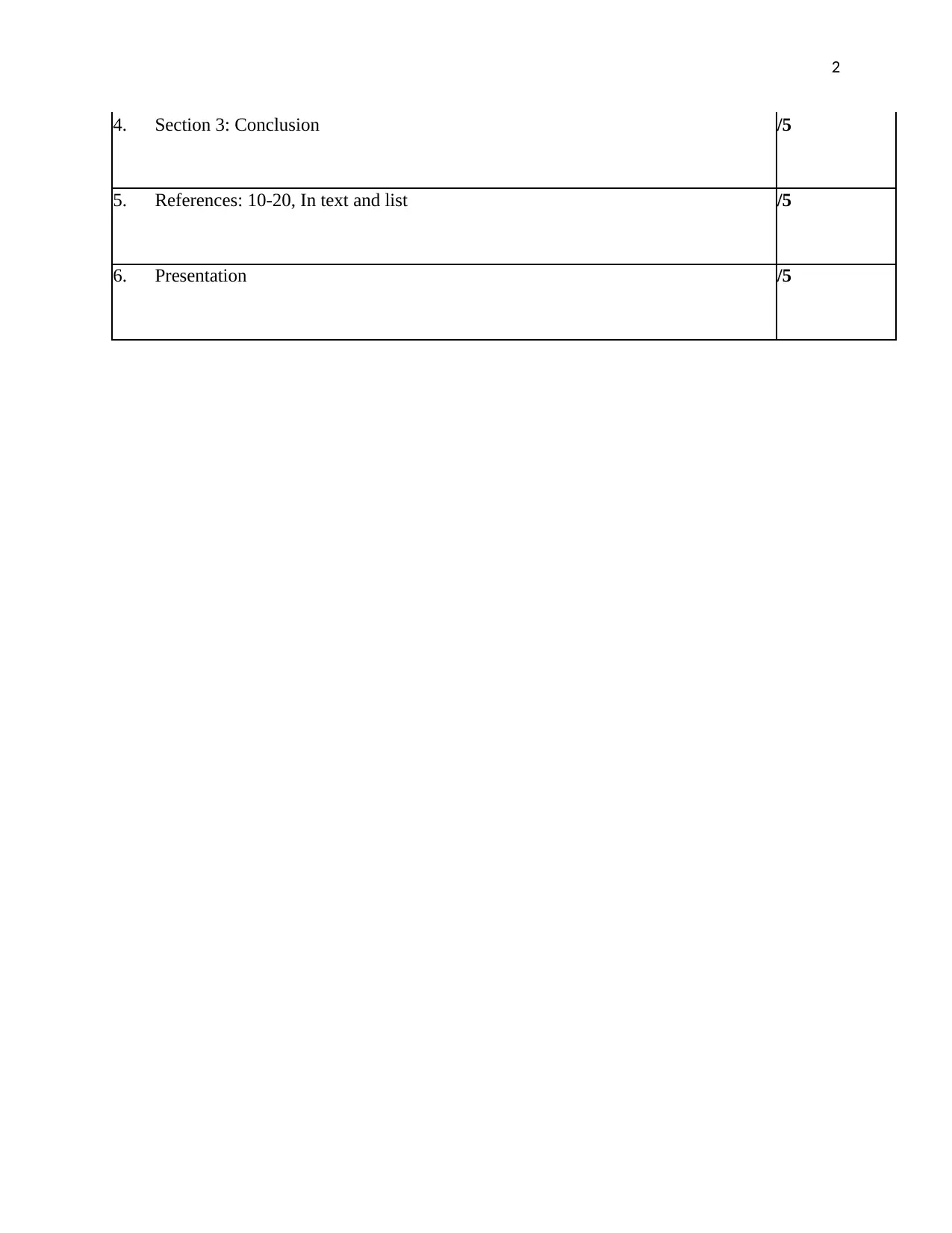
2
4. Section 3: Conclusion /5
5. References: 10-20, In text and list /5
6. Presentation /5
4. Section 3: Conclusion /5
5. References: 10-20, In text and list /5
6. Presentation /5
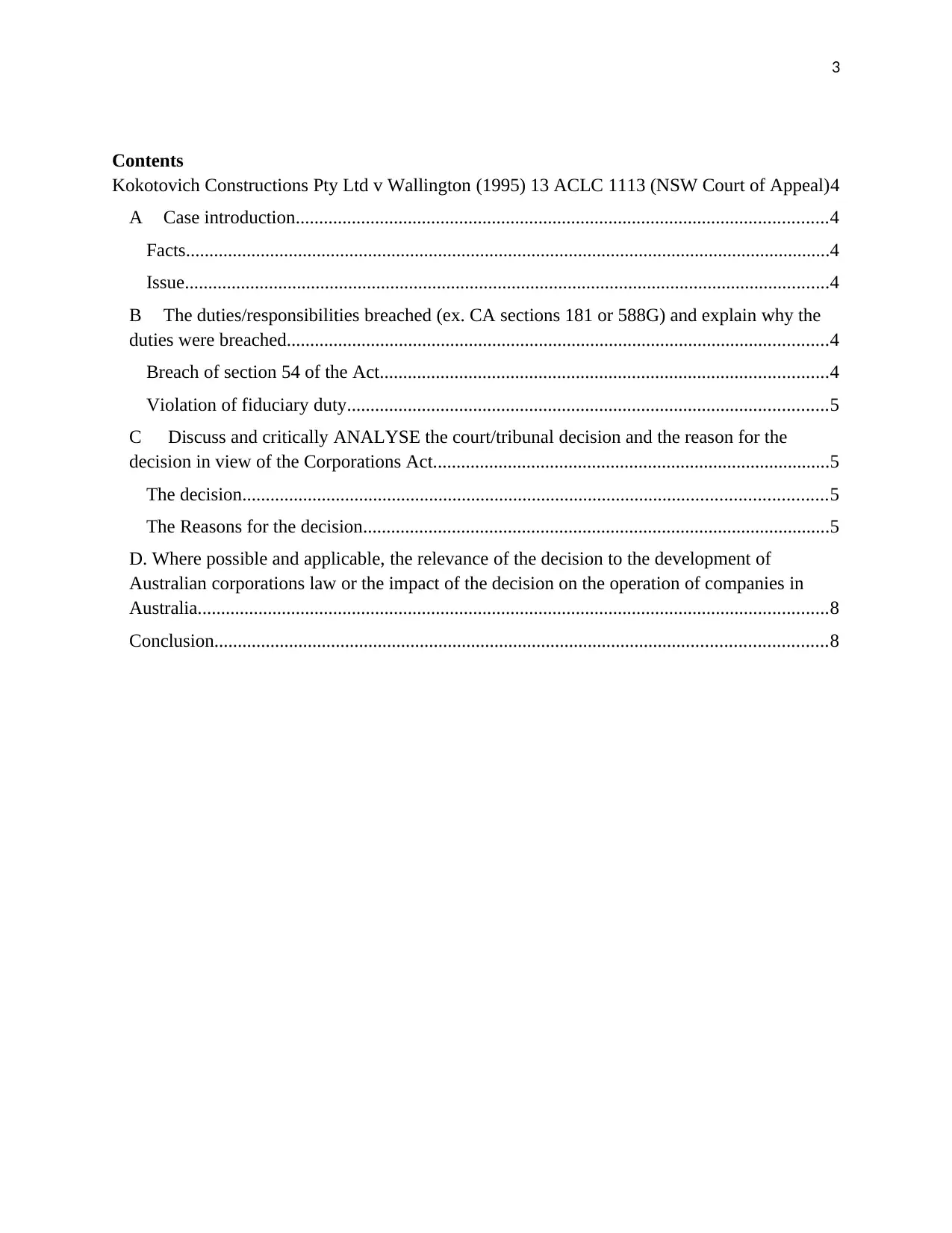
3
Contents
Kokotovich Constructions Pty Ltd v Wallington (1995) 13 ACLC 1113 (NSW Court of Appeal)4
A Case introduction..................................................................................................................4
Facts..........................................................................................................................................4
Issue..........................................................................................................................................4
B The duties/responsibilities breached (ex. CA sections 181 or 588G) and explain why the
duties were breached....................................................................................................................4
Breach of section 54 of the Act................................................................................................4
Violation of fiduciary duty.......................................................................................................5
C Discuss and critically ANALYSE the court/tribunal decision and the reason for the
decision in view of the Corporations Act.....................................................................................5
The decision.............................................................................................................................5
The Reasons for the decision....................................................................................................5
D. Where possible and applicable, the relevance of the decision to the development of
Australian corporations law or the impact of the decision on the operation of companies in
Australia.......................................................................................................................................8
Conclusion...................................................................................................................................8
Contents
Kokotovich Constructions Pty Ltd v Wallington (1995) 13 ACLC 1113 (NSW Court of Appeal)4
A Case introduction..................................................................................................................4
Facts..........................................................................................................................................4
Issue..........................................................................................................................................4
B The duties/responsibilities breached (ex. CA sections 181 or 588G) and explain why the
duties were breached....................................................................................................................4
Breach of section 54 of the Act................................................................................................4
Violation of fiduciary duty.......................................................................................................5
C Discuss and critically ANALYSE the court/tribunal decision and the reason for the
decision in view of the Corporations Act.....................................................................................5
The decision.............................................................................................................................5
The Reasons for the decision....................................................................................................5
D. Where possible and applicable, the relevance of the decision to the development of
Australian corporations law or the impact of the decision on the operation of companies in
Australia.......................................................................................................................................8
Conclusion...................................................................................................................................8
⊘ This is a preview!⊘
Do you want full access?
Subscribe today to unlock all pages.

Trusted by 1+ million students worldwide
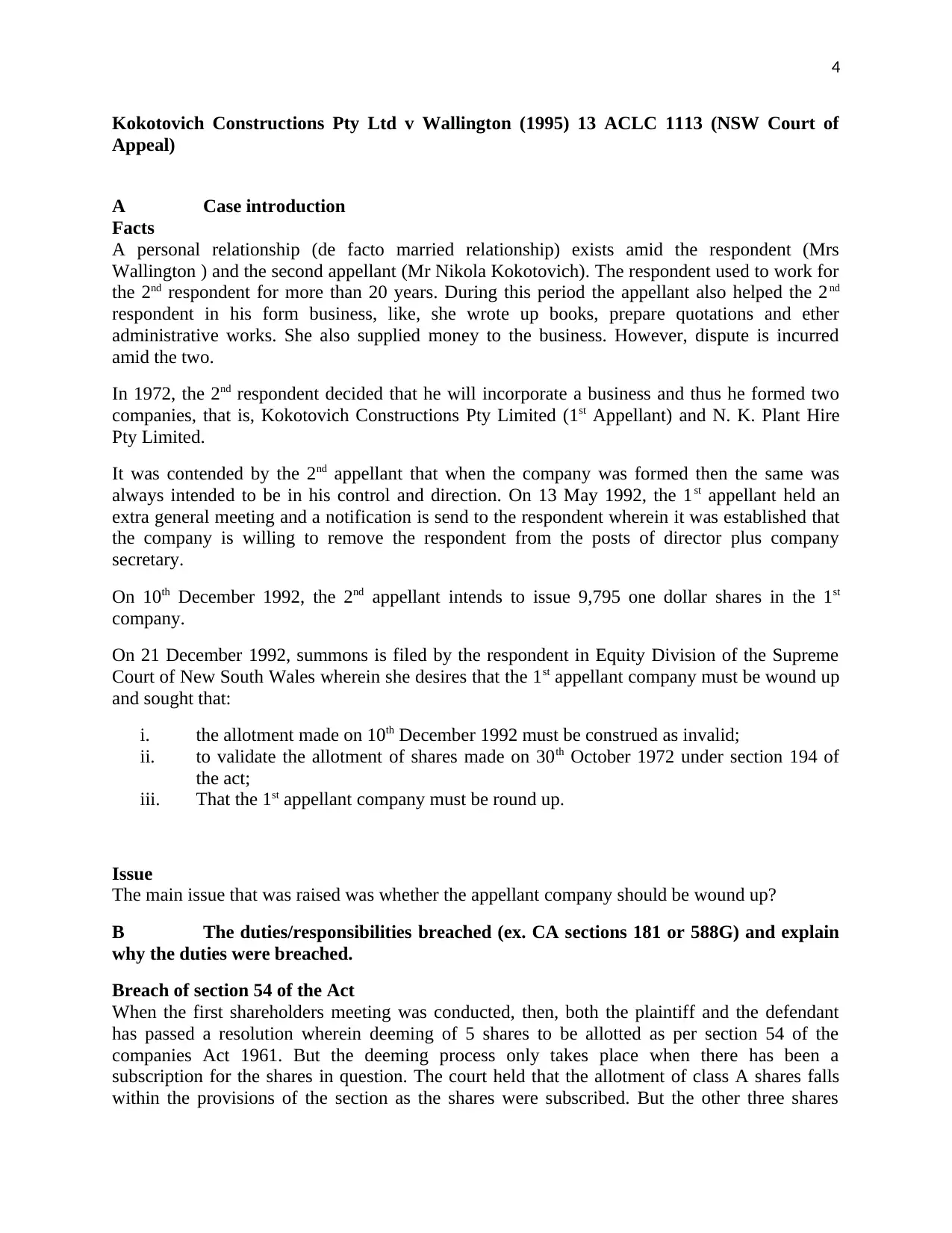
4
Kokotovich Constructions Pty Ltd v Wallington (1995) 13 ACLC 1113 (NSW Court of
Appeal)
A Case introduction
Facts
A personal relationship (de facto married relationship) exists amid the respondent (Mrs
Wallington ) and the second appellant (Mr Nikola Kokotovich). The respondent used to work for
the 2nd respondent for more than 20 years. During this period the appellant also helped the 2nd
respondent in his form business, like, she wrote up books, prepare quotations and ether
administrative works. She also supplied money to the business. However, dispute is incurred
amid the two.
In 1972, the 2nd respondent decided that he will incorporate a business and thus he formed two
companies, that is, Kokotovich Constructions Pty Limited (1st Appellant) and N. K. Plant Hire
Pty Limited.
It was contended by the 2nd appellant that when the company was formed then the same was
always intended to be in his control and direction. On 13 May 1992, the 1st appellant held an
extra general meeting and a notification is send to the respondent wherein it was established that
the company is willing to remove the respondent from the posts of director plus company
secretary.
On 10th December 1992, the 2nd appellant intends to issue 9,795 one dollar shares in the 1st
company.
On 21 December 1992, summons is filed by the respondent in Equity Division of the Supreme
Court of New South Wales wherein she desires that the 1st appellant company must be wound up
and sought that:
i. the allotment made on 10th December 1992 must be construed as invalid;
ii. to validate the allotment of shares made on 30th October 1972 under section 194 of
the act;
iii. That the 1st appellant company must be round up.
Issue
The main issue that was raised was whether the appellant company should be wound up?
B The duties/responsibilities breached (ex. CA sections 181 or 588G) and explain
why the duties were breached.
Breach of section 54 of the Act
When the first shareholders meeting was conducted, then, both the plaintiff and the defendant
has passed a resolution wherein deeming of 5 shares to be allotted as per section 54 of the
companies Act 1961. But the deeming process only takes place when there has been a
subscription for the shares in question. The court held that the allotment of class A shares falls
within the provisions of the section as the shares were subscribed. But the other three shares
Kokotovich Constructions Pty Ltd v Wallington (1995) 13 ACLC 1113 (NSW Court of
Appeal)
A Case introduction
Facts
A personal relationship (de facto married relationship) exists amid the respondent (Mrs
Wallington ) and the second appellant (Mr Nikola Kokotovich). The respondent used to work for
the 2nd respondent for more than 20 years. During this period the appellant also helped the 2nd
respondent in his form business, like, she wrote up books, prepare quotations and ether
administrative works. She also supplied money to the business. However, dispute is incurred
amid the two.
In 1972, the 2nd respondent decided that he will incorporate a business and thus he formed two
companies, that is, Kokotovich Constructions Pty Limited (1st Appellant) and N. K. Plant Hire
Pty Limited.
It was contended by the 2nd appellant that when the company was formed then the same was
always intended to be in his control and direction. On 13 May 1992, the 1st appellant held an
extra general meeting and a notification is send to the respondent wherein it was established that
the company is willing to remove the respondent from the posts of director plus company
secretary.
On 10th December 1992, the 2nd appellant intends to issue 9,795 one dollar shares in the 1st
company.
On 21 December 1992, summons is filed by the respondent in Equity Division of the Supreme
Court of New South Wales wherein she desires that the 1st appellant company must be wound up
and sought that:
i. the allotment made on 10th December 1992 must be construed as invalid;
ii. to validate the allotment of shares made on 30th October 1972 under section 194 of
the act;
iii. That the 1st appellant company must be round up.
Issue
The main issue that was raised was whether the appellant company should be wound up?
B The duties/responsibilities breached (ex. CA sections 181 or 588G) and explain
why the duties were breached.
Breach of section 54 of the Act
When the first shareholders meeting was conducted, then, both the plaintiff and the defendant
has passed a resolution wherein deeming of 5 shares to be allotted as per section 54 of the
companies Act 1961. But the deeming process only takes place when there has been a
subscription for the shares in question. The court held that the allotment of class A shares falls
within the provisions of the section as the shares were subscribed. But the other three shares
Paraphrase This Document
Need a fresh take? Get an instant paraphrase of this document with our AI Paraphraser
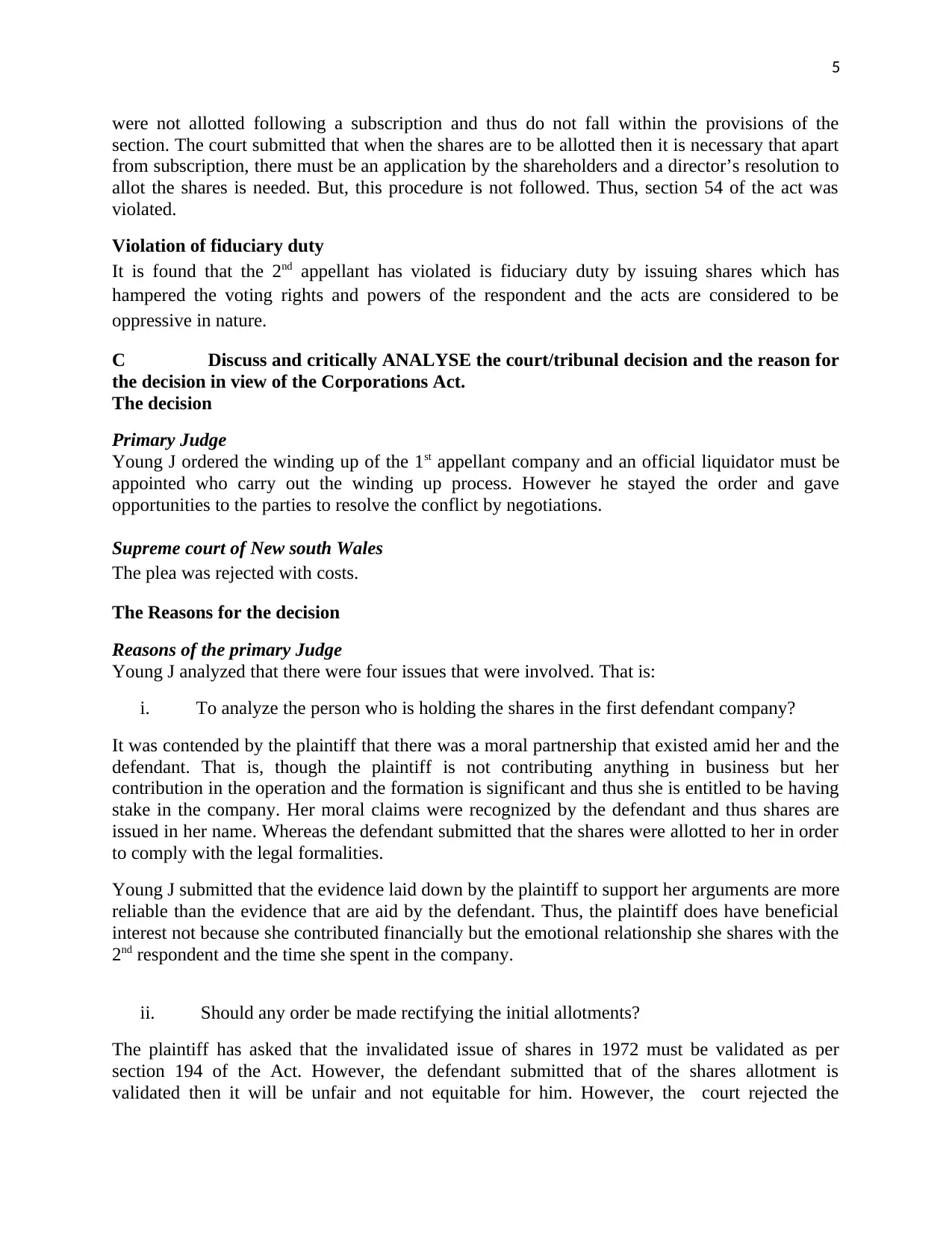
5
were not allotted following a subscription and thus do not fall within the provisions of the
section. The court submitted that when the shares are to be allotted then it is necessary that apart
from subscription, there must be an application by the shareholders and a director’s resolution to
allot the shares is needed. But, this procedure is not followed. Thus, section 54 of the act was
violated.
Violation of fiduciary duty
It is found that the 2nd appellant has violated is fiduciary duty by issuing shares which has
hampered the voting rights and powers of the respondent and the acts are considered to be
oppressive in nature.
C Discuss and critically ANALYSE the court/tribunal decision and the reason for
the decision in view of the Corporations Act.
The decision
Primary Judge
Young J ordered the winding up of the 1st appellant company and an official liquidator must be
appointed who carry out the winding up process. However he stayed the order and gave
opportunities to the parties to resolve the conflict by negotiations.
Supreme court of New south Wales
The plea was rejected with costs.
The Reasons for the decision
Reasons of the primary Judge
Young J analyzed that there were four issues that were involved. That is:
i. To analyze the person who is holding the shares in the first defendant company?
It was contended by the plaintiff that there was a moral partnership that existed amid her and the
defendant. That is, though the plaintiff is not contributing anything in business but her
contribution in the operation and the formation is significant and thus she is entitled to be having
stake in the company. Her moral claims were recognized by the defendant and thus shares are
issued in her name. Whereas the defendant submitted that the shares were allotted to her in order
to comply with the legal formalities.
Young J submitted that the evidence laid down by the plaintiff to support her arguments are more
reliable than the evidence that are aid by the defendant. Thus, the plaintiff does have beneficial
interest not because she contributed financially but the emotional relationship she shares with the
2nd respondent and the time she spent in the company.
ii. Should any order be made rectifying the initial allotments?
The plaintiff has asked that the invalidated issue of shares in 1972 must be validated as per
section 194 of the Act. However, the defendant submitted that of the shares allotment is
validated then it will be unfair and not equitable for him. However, the court rejected the
were not allotted following a subscription and thus do not fall within the provisions of the
section. The court submitted that when the shares are to be allotted then it is necessary that apart
from subscription, there must be an application by the shareholders and a director’s resolution to
allot the shares is needed. But, this procedure is not followed. Thus, section 54 of the act was
violated.
Violation of fiduciary duty
It is found that the 2nd appellant has violated is fiduciary duty by issuing shares which has
hampered the voting rights and powers of the respondent and the acts are considered to be
oppressive in nature.
C Discuss and critically ANALYSE the court/tribunal decision and the reason for
the decision in view of the Corporations Act.
The decision
Primary Judge
Young J ordered the winding up of the 1st appellant company and an official liquidator must be
appointed who carry out the winding up process. However he stayed the order and gave
opportunities to the parties to resolve the conflict by negotiations.
Supreme court of New south Wales
The plea was rejected with costs.
The Reasons for the decision
Reasons of the primary Judge
Young J analyzed that there were four issues that were involved. That is:
i. To analyze the person who is holding the shares in the first defendant company?
It was contended by the plaintiff that there was a moral partnership that existed amid her and the
defendant. That is, though the plaintiff is not contributing anything in business but her
contribution in the operation and the formation is significant and thus she is entitled to be having
stake in the company. Her moral claims were recognized by the defendant and thus shares are
issued in her name. Whereas the defendant submitted that the shares were allotted to her in order
to comply with the legal formalities.
Young J submitted that the evidence laid down by the plaintiff to support her arguments are more
reliable than the evidence that are aid by the defendant. Thus, the plaintiff does have beneficial
interest not because she contributed financially but the emotional relationship she shares with the
2nd respondent and the time she spent in the company.
ii. Should any order be made rectifying the initial allotments?
The plaintiff has asked that the invalidated issue of shares in 1972 must be validated as per
section 194 of the Act. However, the defendant submitted that of the shares allotment is
validated then it will be unfair and not equitable for him. However, the court rejected the
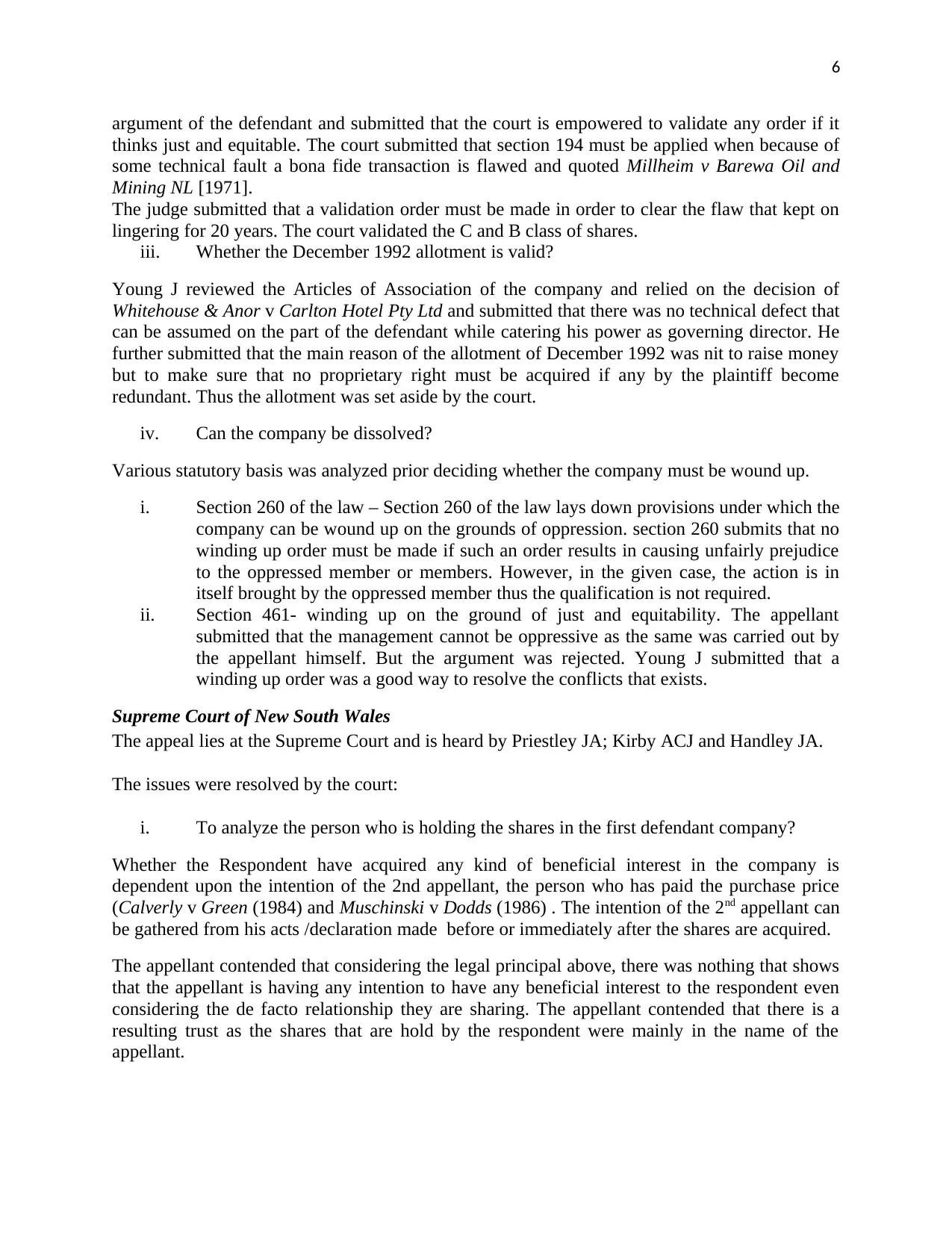
6
argument of the defendant and submitted that the court is empowered to validate any order if it
thinks just and equitable. The court submitted that section 194 must be applied when because of
some technical fault a bona fide transaction is flawed and quoted Millheim v Barewa Oil and
Mining NL [1971].
The judge submitted that a validation order must be made in order to clear the flaw that kept on
lingering for 20 years. The court validated the C and B class of shares.
iii. Whether the December 1992 allotment is valid?
Young J reviewed the Articles of Association of the company and relied on the decision of
Whitehouse & Anor v Carlton Hotel Pty Ltd and submitted that there was no technical defect that
can be assumed on the part of the defendant while catering his power as governing director. He
further submitted that the main reason of the allotment of December 1992 was nit to raise money
but to make sure that no proprietary right must be acquired if any by the plaintiff become
redundant. Thus the allotment was set aside by the court.
iv. Can the company be dissolved?
Various statutory basis was analyzed prior deciding whether the company must be wound up.
i. Section 260 of the law – Section 260 of the law lays down provisions under which the
company can be wound up on the grounds of oppression. section 260 submits that no
winding up order must be made if such an order results in causing unfairly prejudice
to the oppressed member or members. However, in the given case, the action is in
itself brought by the oppressed member thus the qualification is not required.
ii. Section 461- winding up on the ground of just and equitability. The appellant
submitted that the management cannot be oppressive as the same was carried out by
the appellant himself. But the argument was rejected. Young J submitted that a
winding up order was a good way to resolve the conflicts that exists.
Supreme Court of New South Wales
The appeal lies at the Supreme Court and is heard by Priestley JA; Kirby ACJ and Handley JA.
The issues were resolved by the court:
i. To analyze the person who is holding the shares in the first defendant company?
Whether the Respondent have acquired any kind of beneficial interest in the company is
dependent upon the intention of the 2nd appellant, the person who has paid the purchase price
(Calverly v Green (1984) and Muschinski v Dodds (1986) . The intention of the 2nd appellant can
be gathered from his acts /declaration made before or immediately after the shares are acquired.
The appellant contended that considering the legal principal above, there was nothing that shows
that the appellant is having any intention to have any beneficial interest to the respondent even
considering the de facto relationship they are sharing. The appellant contended that there is a
resulting trust as the shares that are hold by the respondent were mainly in the name of the
appellant.
argument of the defendant and submitted that the court is empowered to validate any order if it
thinks just and equitable. The court submitted that section 194 must be applied when because of
some technical fault a bona fide transaction is flawed and quoted Millheim v Barewa Oil and
Mining NL [1971].
The judge submitted that a validation order must be made in order to clear the flaw that kept on
lingering for 20 years. The court validated the C and B class of shares.
iii. Whether the December 1992 allotment is valid?
Young J reviewed the Articles of Association of the company and relied on the decision of
Whitehouse & Anor v Carlton Hotel Pty Ltd and submitted that there was no technical defect that
can be assumed on the part of the defendant while catering his power as governing director. He
further submitted that the main reason of the allotment of December 1992 was nit to raise money
but to make sure that no proprietary right must be acquired if any by the plaintiff become
redundant. Thus the allotment was set aside by the court.
iv. Can the company be dissolved?
Various statutory basis was analyzed prior deciding whether the company must be wound up.
i. Section 260 of the law – Section 260 of the law lays down provisions under which the
company can be wound up on the grounds of oppression. section 260 submits that no
winding up order must be made if such an order results in causing unfairly prejudice
to the oppressed member or members. However, in the given case, the action is in
itself brought by the oppressed member thus the qualification is not required.
ii. Section 461- winding up on the ground of just and equitability. The appellant
submitted that the management cannot be oppressive as the same was carried out by
the appellant himself. But the argument was rejected. Young J submitted that a
winding up order was a good way to resolve the conflicts that exists.
Supreme Court of New South Wales
The appeal lies at the Supreme Court and is heard by Priestley JA; Kirby ACJ and Handley JA.
The issues were resolved by the court:
i. To analyze the person who is holding the shares in the first defendant company?
Whether the Respondent have acquired any kind of beneficial interest in the company is
dependent upon the intention of the 2nd appellant, the person who has paid the purchase price
(Calverly v Green (1984) and Muschinski v Dodds (1986) . The intention of the 2nd appellant can
be gathered from his acts /declaration made before or immediately after the shares are acquired.
The appellant contended that considering the legal principal above, there was nothing that shows
that the appellant is having any intention to have any beneficial interest to the respondent even
considering the de facto relationship they are sharing. The appellant contended that there is a
resulting trust as the shares that are hold by the respondent were mainly in the name of the
appellant.
⊘ This is a preview!⊘
Do you want full access?
Subscribe today to unlock all pages.

Trusted by 1+ million students worldwide
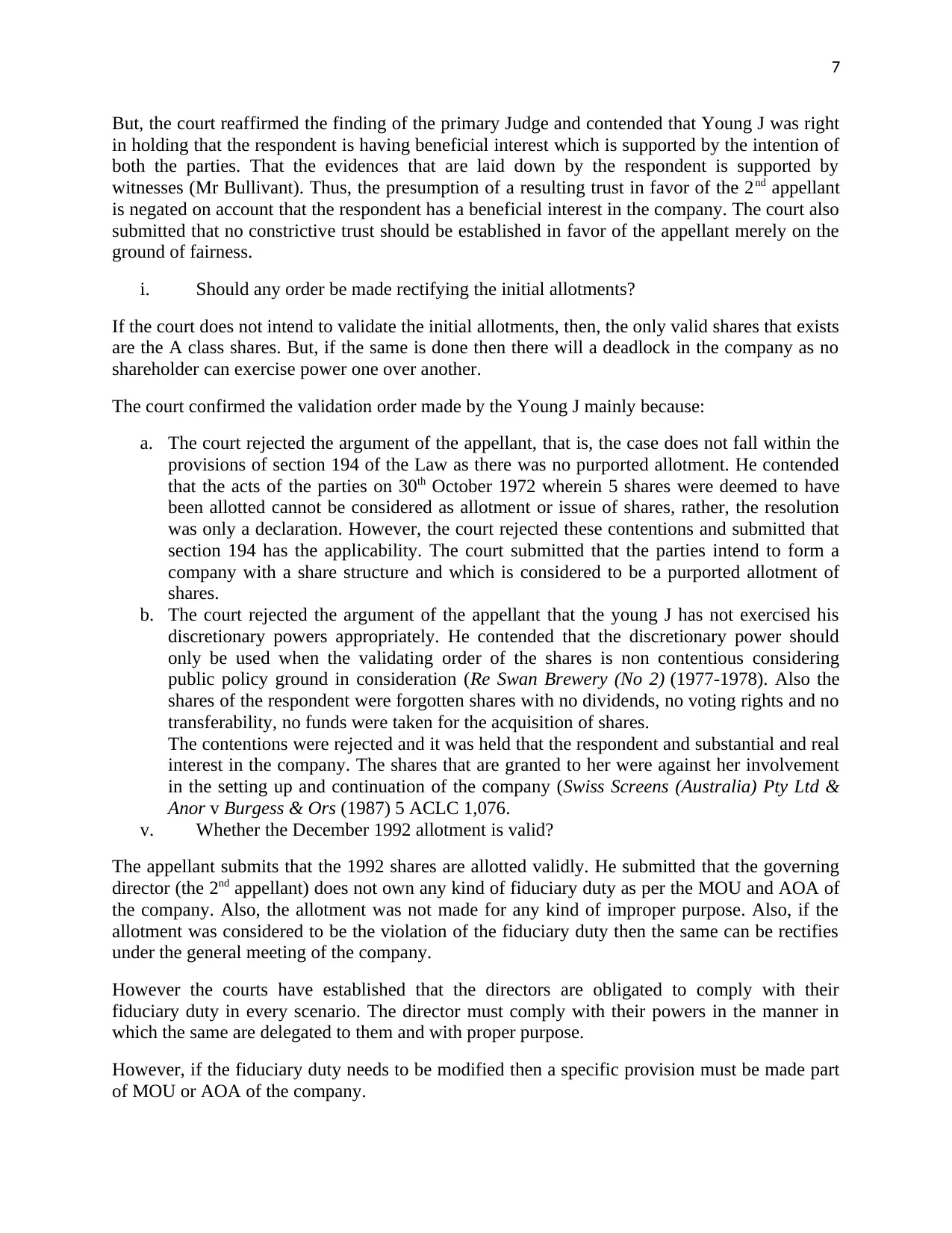
7
But, the court reaffirmed the finding of the primary Judge and contended that Young J was right
in holding that the respondent is having beneficial interest which is supported by the intention of
both the parties. That the evidences that are laid down by the respondent is supported by
witnesses (Mr Bullivant). Thus, the presumption of a resulting trust in favor of the 2nd appellant
is negated on account that the respondent has a beneficial interest in the company. The court also
submitted that no constrictive trust should be established in favor of the appellant merely on the
ground of fairness.
i. Should any order be made rectifying the initial allotments?
If the court does not intend to validate the initial allotments, then, the only valid shares that exists
are the A class shares. But, if the same is done then there will a deadlock in the company as no
shareholder can exercise power one over another.
The court confirmed the validation order made by the Young J mainly because:
a. The court rejected the argument of the appellant, that is, the case does not fall within the
provisions of section 194 of the Law as there was no purported allotment. He contended
that the acts of the parties on 30th October 1972 wherein 5 shares were deemed to have
been allotted cannot be considered as allotment or issue of shares, rather, the resolution
was only a declaration. However, the court rejected these contentions and submitted that
section 194 has the applicability. The court submitted that the parties intend to form a
company with a share structure and which is considered to be a purported allotment of
shares.
b. The court rejected the argument of the appellant that the young J has not exercised his
discretionary powers appropriately. He contended that the discretionary power should
only be used when the validating order of the shares is non contentious considering
public policy ground in consideration (Re Swan Brewery (No 2) (1977-1978). Also the
shares of the respondent were forgotten shares with no dividends, no voting rights and no
transferability, no funds were taken for the acquisition of shares.
The contentions were rejected and it was held that the respondent and substantial and real
interest in the company. The shares that are granted to her were against her involvement
in the setting up and continuation of the company (Swiss Screens (Australia) Pty Ltd &
Anor v Burgess & Ors (1987) 5 ACLC 1,076.
v. Whether the December 1992 allotment is valid?
The appellant submits that the 1992 shares are allotted validly. He submitted that the governing
director (the 2nd appellant) does not own any kind of fiduciary duty as per the MOU and AOA of
the company. Also, the allotment was not made for any kind of improper purpose. Also, if the
allotment was considered to be the violation of the fiduciary duty then the same can be rectifies
under the general meeting of the company.
However the courts have established that the directors are obligated to comply with their
fiduciary duty in every scenario. The director must comply with their powers in the manner in
which the same are delegated to them and with proper purpose.
However, if the fiduciary duty needs to be modified then a specific provision must be made part
of MOU or AOA of the company.
But, the court reaffirmed the finding of the primary Judge and contended that Young J was right
in holding that the respondent is having beneficial interest which is supported by the intention of
both the parties. That the evidences that are laid down by the respondent is supported by
witnesses (Mr Bullivant). Thus, the presumption of a resulting trust in favor of the 2nd appellant
is negated on account that the respondent has a beneficial interest in the company. The court also
submitted that no constrictive trust should be established in favor of the appellant merely on the
ground of fairness.
i. Should any order be made rectifying the initial allotments?
If the court does not intend to validate the initial allotments, then, the only valid shares that exists
are the A class shares. But, if the same is done then there will a deadlock in the company as no
shareholder can exercise power one over another.
The court confirmed the validation order made by the Young J mainly because:
a. The court rejected the argument of the appellant, that is, the case does not fall within the
provisions of section 194 of the Law as there was no purported allotment. He contended
that the acts of the parties on 30th October 1972 wherein 5 shares were deemed to have
been allotted cannot be considered as allotment or issue of shares, rather, the resolution
was only a declaration. However, the court rejected these contentions and submitted that
section 194 has the applicability. The court submitted that the parties intend to form a
company with a share structure and which is considered to be a purported allotment of
shares.
b. The court rejected the argument of the appellant that the young J has not exercised his
discretionary powers appropriately. He contended that the discretionary power should
only be used when the validating order of the shares is non contentious considering
public policy ground in consideration (Re Swan Brewery (No 2) (1977-1978). Also the
shares of the respondent were forgotten shares with no dividends, no voting rights and no
transferability, no funds were taken for the acquisition of shares.
The contentions were rejected and it was held that the respondent and substantial and real
interest in the company. The shares that are granted to her were against her involvement
in the setting up and continuation of the company (Swiss Screens (Australia) Pty Ltd &
Anor v Burgess & Ors (1987) 5 ACLC 1,076.
v. Whether the December 1992 allotment is valid?
The appellant submits that the 1992 shares are allotted validly. He submitted that the governing
director (the 2nd appellant) does not own any kind of fiduciary duty as per the MOU and AOA of
the company. Also, the allotment was not made for any kind of improper purpose. Also, if the
allotment was considered to be the violation of the fiduciary duty then the same can be rectifies
under the general meeting of the company.
However the courts have established that the directors are obligated to comply with their
fiduciary duty in every scenario. The director must comply with their powers in the manner in
which the same are delegated to them and with proper purpose.
However, if the fiduciary duty needs to be modified then a specific provision must be made part
of MOU or AOA of the company.
Paraphrase This Document
Need a fresh take? Get an instant paraphrase of this document with our AI Paraphraser
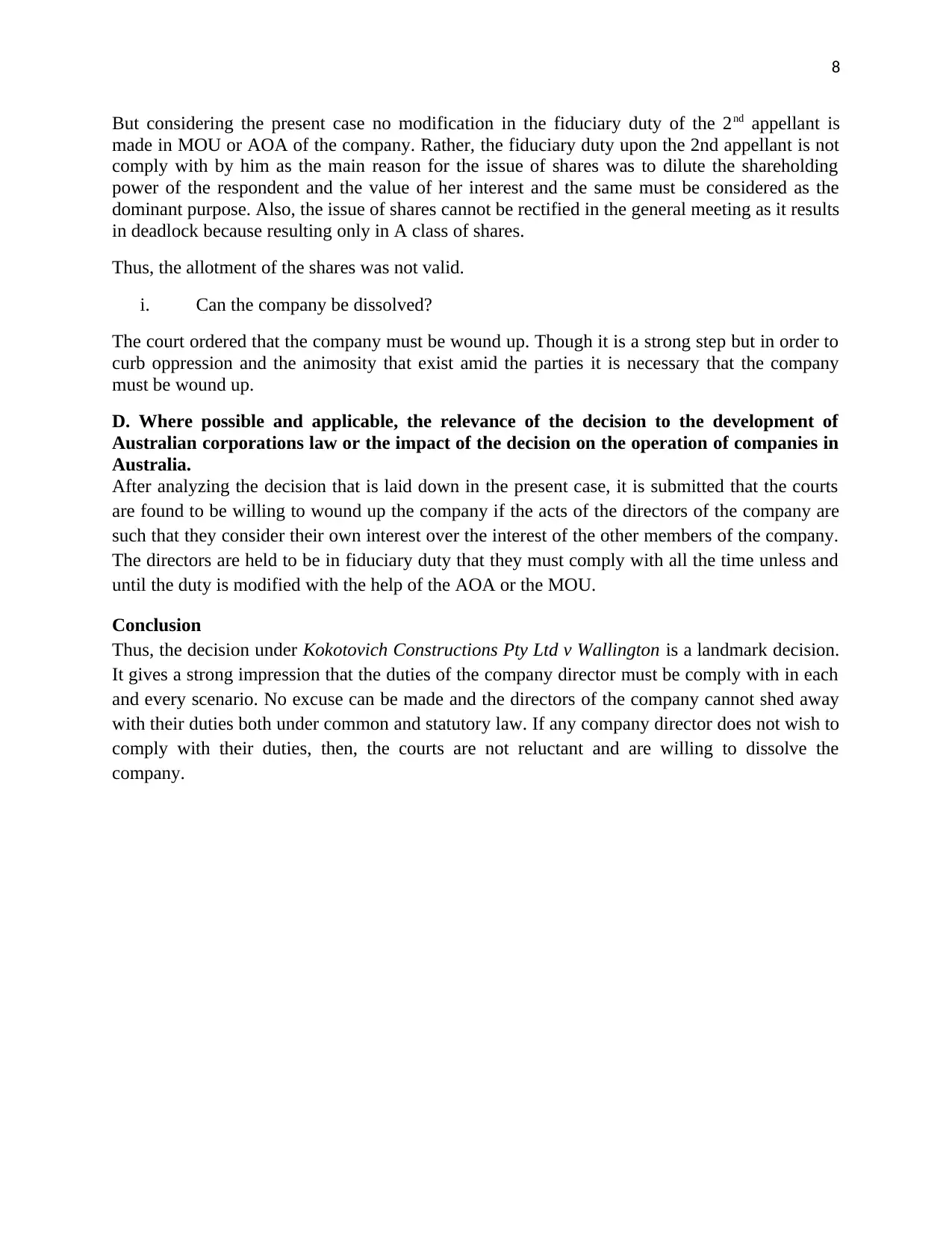
8
But considering the present case no modification in the fiduciary duty of the 2nd appellant is
made in MOU or AOA of the company. Rather, the fiduciary duty upon the 2nd appellant is not
comply with by him as the main reason for the issue of shares was to dilute the shareholding
power of the respondent and the value of her interest and the same must be considered as the
dominant purpose. Also, the issue of shares cannot be rectified in the general meeting as it results
in deadlock because resulting only in A class of shares.
Thus, the allotment of the shares was not valid.
i. Can the company be dissolved?
The court ordered that the company must be wound up. Though it is a strong step but in order to
curb oppression and the animosity that exist amid the parties it is necessary that the company
must be wound up.
D. Where possible and applicable, the relevance of the decision to the development of
Australian corporations law or the impact of the decision on the operation of companies in
Australia.
After analyzing the decision that is laid down in the present case, it is submitted that the courts
are found to be willing to wound up the company if the acts of the directors of the company are
such that they consider their own interest over the interest of the other members of the company.
The directors are held to be in fiduciary duty that they must comply with all the time unless and
until the duty is modified with the help of the AOA or the MOU.
Conclusion
Thus, the decision under Kokotovich Constructions Pty Ltd v Wallington is a landmark decision.
It gives a strong impression that the duties of the company director must be comply with in each
and every scenario. No excuse can be made and the directors of the company cannot shed away
with their duties both under common and statutory law. If any company director does not wish to
comply with their duties, then, the courts are not reluctant and are willing to dissolve the
company.
But considering the present case no modification in the fiduciary duty of the 2nd appellant is
made in MOU or AOA of the company. Rather, the fiduciary duty upon the 2nd appellant is not
comply with by him as the main reason for the issue of shares was to dilute the shareholding
power of the respondent and the value of her interest and the same must be considered as the
dominant purpose. Also, the issue of shares cannot be rectified in the general meeting as it results
in deadlock because resulting only in A class of shares.
Thus, the allotment of the shares was not valid.
i. Can the company be dissolved?
The court ordered that the company must be wound up. Though it is a strong step but in order to
curb oppression and the animosity that exist amid the parties it is necessary that the company
must be wound up.
D. Where possible and applicable, the relevance of the decision to the development of
Australian corporations law or the impact of the decision on the operation of companies in
Australia.
After analyzing the decision that is laid down in the present case, it is submitted that the courts
are found to be willing to wound up the company if the acts of the directors of the company are
such that they consider their own interest over the interest of the other members of the company.
The directors are held to be in fiduciary duty that they must comply with all the time unless and
until the duty is modified with the help of the AOA or the MOU.
Conclusion
Thus, the decision under Kokotovich Constructions Pty Ltd v Wallington is a landmark decision.
It gives a strong impression that the duties of the company director must be comply with in each
and every scenario. No excuse can be made and the directors of the company cannot shed away
with their duties both under common and statutory law. If any company director does not wish to
comply with their duties, then, the courts are not reluctant and are willing to dissolve the
company.
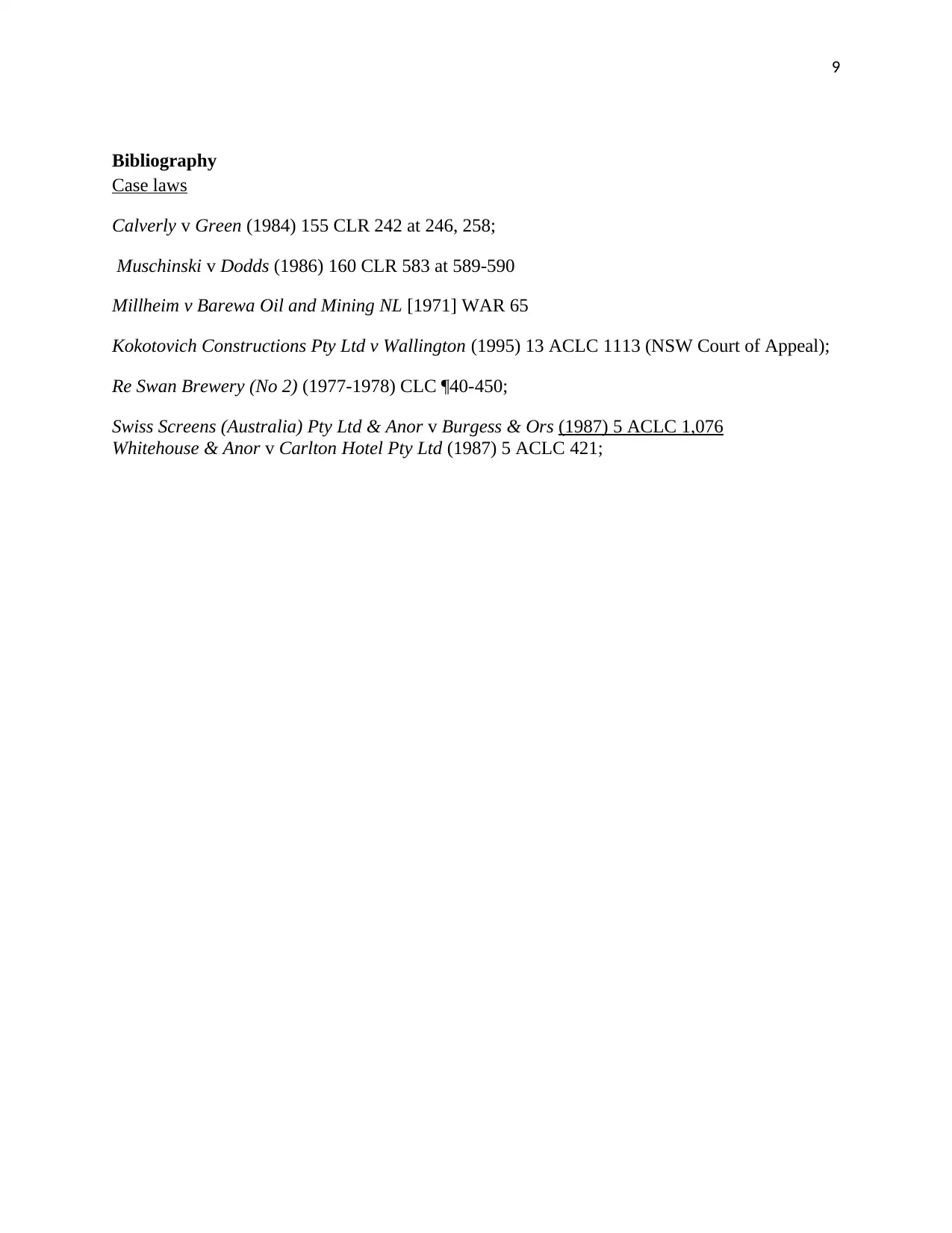
9
Bibliography
Case laws
Calverly v Green (1984) 155 CLR 242 at 246, 258;
Muschinski v Dodds (1986) 160 CLR 583 at 589-590
Millheim v Barewa Oil and Mining NL [1971] WAR 65
Kokotovich Constructions Pty Ltd v Wallington (1995) 13 ACLC 1113 (NSW Court of Appeal);
Re Swan Brewery (No 2) (1977-1978) CLC ¶40-450;
Swiss Screens (Australia) Pty Ltd & Anor v Burgess & Ors (1987) 5 ACLC 1,076
Whitehouse & Anor v Carlton Hotel Pty Ltd (1987) 5 ACLC 421;
Bibliography
Case laws
Calverly v Green (1984) 155 CLR 242 at 246, 258;
Muschinski v Dodds (1986) 160 CLR 583 at 589-590
Millheim v Barewa Oil and Mining NL [1971] WAR 65
Kokotovich Constructions Pty Ltd v Wallington (1995) 13 ACLC 1113 (NSW Court of Appeal);
Re Swan Brewery (No 2) (1977-1978) CLC ¶40-450;
Swiss Screens (Australia) Pty Ltd & Anor v Burgess & Ors (1987) 5 ACLC 1,076
Whitehouse & Anor v Carlton Hotel Pty Ltd (1987) 5 ACLC 421;
⊘ This is a preview!⊘
Do you want full access?
Subscribe today to unlock all pages.

Trusted by 1+ million students worldwide
1 out of 9
Your All-in-One AI-Powered Toolkit for Academic Success.
+13062052269
info@desklib.com
Available 24*7 on WhatsApp / Email
![[object Object]](/_next/static/media/star-bottom.7253800d.svg)
Unlock your academic potential
Copyright © 2020–2025 A2Z Services. All Rights Reserved. Developed and managed by ZUCOL.


